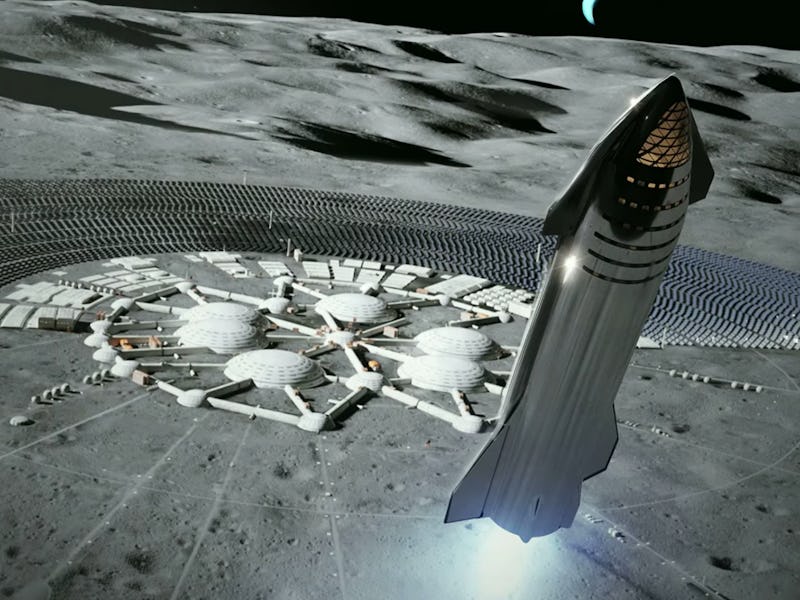SpaceX’s grand ambitions for space are hitting a key stumbling block
The space-faring firm wants to make space travel more accessible, but it will have to overcome some key issues first.

SpaceX has delayed another of its satellite launches, as it pushes to advance spaceflight further than ever. While the company is aiming to establish a base on the moon and a city on Mars, its plans rest on reusing rockets faster than ever – but it's struggling to get those times down.
On Monday, SpaceflightNow reported that SpaceX was planning to delay the launch of the Anasis 2 satellite. This was expected to send up a South Korean military satellite using a Falcon 9 rocket, taking off from Space Launch Complex 40 at Cape Canaveral Air Force Station. The launch window was set to open at 5 p.m. Eastern time.
Later that day, SpaceX confirmed the delay via its Twitter page. The firm indicated that the rocket required more checks before flying, due to issues with the disposable second stage:
"Standing down from tomorrow’s launch of ANASIS-II to take a closer look at the second stage, swap hardware if needed. Will announce new target launch date once confirmed on the Range."
In response to the publication, CEO Elon Musk wrote on his Twitter page Monday:
"We’re being extra paranoid. Maximizing probability of successful launch is paramount."
The delay shows how SpaceX is working to increase the speed at which it reuses rockets, but it's still facing issues. The company's current record for the fastest time between flights for a single first stage booster is 62 days, set by the B1056 booster in February 2020 when it launched the fifth batch of Starlink satellites. Had SpaceX flown on schedule, this week's launch would have re-used the same first stage booster 45 days after its previous flight, beating the record by 17 days.
Note that while SpaceX is aiming to reuse the first stage booster as fast as possible, in this situation it was the disposable second stage that caused the delay. The first stage is used for the initial lift-off, before separating and allowing the weaker second stage to send the payload to the desired location. While SpaceX's goal is to reuse the first stage as fast as possible, delays like these can happen and show why a faster turnaround time is easier said than done.
Why does all this matter? Because SpaceX is aiming to reduce the cost of spaceflight, and reusing rockets is one part of that. Saving the Falcon 9 booster from each mission saves around $46.5 million of the estimated $62 million price tag associated with each Falcon 9 launch. Musk has compared the problem as akin to reusing airplanes: building in a landing gear and other extras make the economics of air travel completely different.
SpaceX has made big strides toward this goal. It first tried to land a booster in 2013. It first succeeded the following year. In 2017 it successfully landed every booster it attempted to land. The team has landed 55 cores in total. The company currently has five Falcon 9 boosters in its lineup. SpaceX's efforts recently received the thumbs-up from NASA, which cleared the way this month to fly astronauts on reused capsules and boosters.
Falcon 9 coming in to land.
But Musk wants to go further. In March 2017, Musk declared that his goal was to reach a 24-hour turnaround. This, company president Gwynne Shotwell explained, would offer "true operational reusability, like an aircraft." In May 2017, the company outlined the "Block 5" variant that would make this happen. Unfortunately, it's not quite yet reached that target.
Musk has big plans to go even further than a 24-hour turnaround. The Starship, the next-generation rocket currently under development at the firm's Boca Chica facility in Texas, is designed with full reusability in mind. SpaceX's end goal with the Starship is to fly the same ship 1,000 times per year, meaning launches up to three times per day. That will enable SpaceX to send up more cargo than ever, paving the way for thousands of tons to help support a moon city or Mars base.
The Inverse analysis – Reusing rockets is not as easy as it may seem, as this recent delay indicates. But while SpaceX wants to reuse rockets more often than ever, it also wants to ensure it maintains its reputation for dependability and safety. Flying a rocket that's not ready to fly would be unwise, even if it breaks SpaceX's records.
But even if it fails to break the record just yet, it will have plenty of chances this year. SpaceXStats shows the firm is scheduled to complete more launches this year than ever before, reaching a total of 25. As it builds out the Starlink and sends more NASA astronauts into space, there will be other times to push its timings down.
Update 07/16 6:30 a.m. Eastern time: This article has been updated to further clarify the differences between the first and second stage.